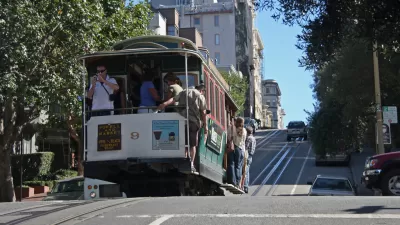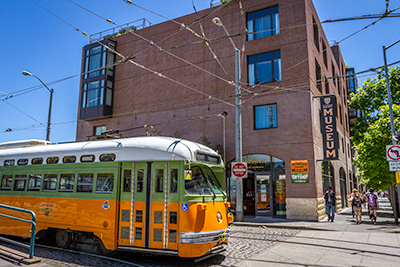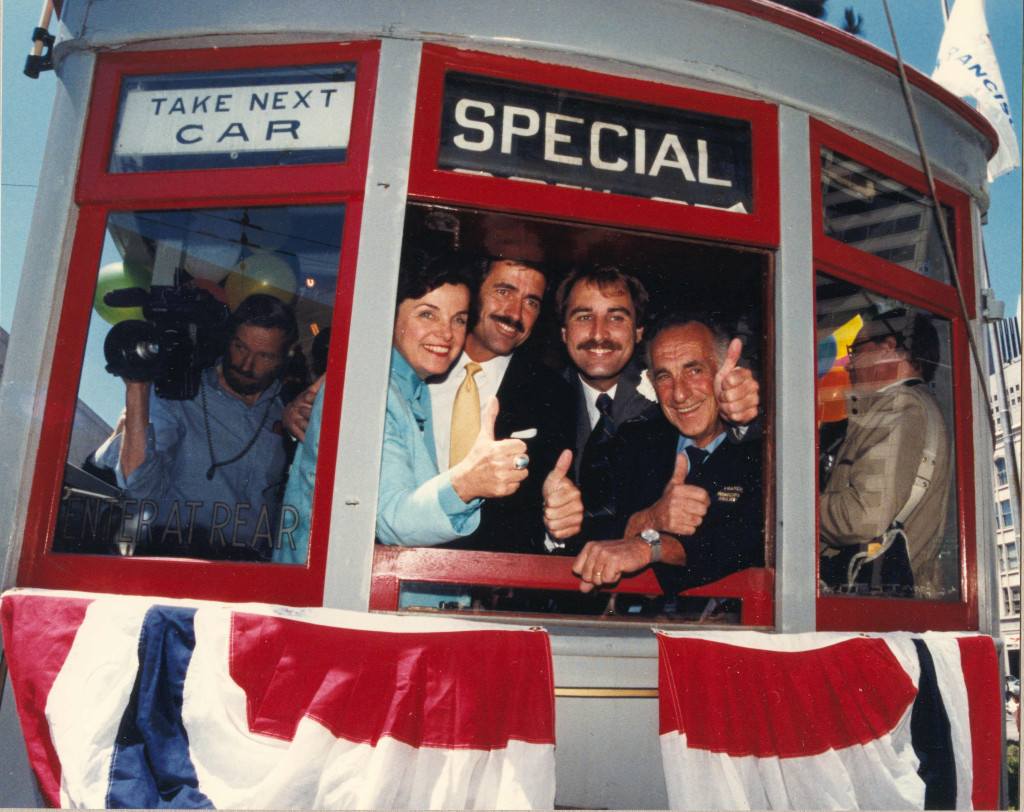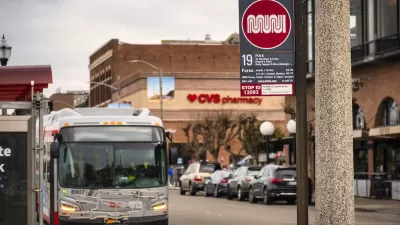As Joe Fitzgerald Rodriguez of the San Francisco Examiner explains, the 'E' Line has only been over three decades in the making. Credit goes greatly to former mayor, now U.S. Senator Diane Feinstein, and the tireless work of committed advocates.

San Francisco's historic or vintage streetcar line is about to double in size. The crowded F Line, operating from Castro Street to Fisherman's Wharf, will soon be sharing streetcars and tracks with its sister line, the E-Embarcadero Line, operating from the Caltrain station, past AT&T (San Francisco Giants) ballpark, merging with the F Line at the Ferry Building, and continuing to Fisherman's Wharf.
Credit: San Francisco Railway Museum • On the F-Line • Steuart St. Stop
"Originally conceived by San Francisco Tomorrow in the 1970s, it wasn’t until [U.S. Sen. Dianne Feinstein, then-San Francisco mayor] backed the project in the ’80s that the trolley’s future was secured," writes Joe Fitzgerald Rodriguez for the San Francisco Examiner.
"It takes a tremendous amount of patience to make dreams come true in San Francisco,” said Rick Laubscher, president of the Market Street Railway Association, a "non-profit group dedicated to the acquisition, restoration and operation of historic transit vehicles in the city," according to the San Francisco Municipal Transportation Authority (SFMTA), the city's public transit operator.
Rodriguez does an excellent job of explaining the history behind the E Line, crediting those who made it happen; so much so that Market Street Railway wrote their own article, "Great E-line Startup Piece in The Examiner." The new E Line will operate on weekends only beginning August 1 with daily service to start next year. Joe Fitzgerald Rodriguez fittingly provides the recent history for the historic line.
"Right after this shot was snapped, Mayor Dianne Feinstein (left) took the controls of Muni Car No.1 and personally piloted it down Market Street to open the first Trolley Festival in June 1983. That success led to the permanent F-line, and now the E-line." Credit: Market Street Railway.
Feinstein's role can not be downplayed. Just as Mayor Michael Bloomberg played an instrumental role in the creation of New York's High Line after his predecessor, Mayor Rudolph Giuliani, tried to kill it, as noted here, Feinstein, working with MTA and Market Street Railway got the F Line, and now the E Line, launched.
“I congratulate the SFMTA on finally achieving this milestone, one we envisioned when I was Mayor,” Feinstein wrote in an email to the Examiner. “Most especially, I am extremely proud of the Market Street Railway Association, led by Rick Laubscher, for their tireless advocacy; without their support, this never would have come to fruition. Now, onto the next challenge — extend the line from Fisherman’s Wharf to Fort Mason!”
On that last note, she refers to an extension from Fisherman's Wharf "through an old tunnel that links Aquatic Park to Fort Mason." The Environmental Impact Statement [PDF] has been completed.
Unlike other historic or replica streetcar lines, San Francisco's streetcars operates more like the oldest public transit in the United States, the New Orleans streetcars, as it serves the local population as well as tourists, as explained here last August.
FULL STORY: Muni set to roll out long-planned waterfront streetcar, the E-line

Planetizen Federal Action Tracker
A weekly monitor of how Trump’s orders and actions are impacting planners and planning in America.

Congressman Proposes Bill to Rename DC Metro “Trump Train”
The Make Autorail Great Again Act would withhold federal funding to the system until the Washington Metropolitan Area Transit Authority (WMATA), rebrands as the Washington Metropolitan Authority for Greater Access (WMAGA).

The Simple Legislative Tool Transforming Vacant Downtowns
In California, Michigan and Georgia, an easy win is bringing dollars — and delight — back to city centers.

The States Losing Rural Delivery Rooms at an Alarming Pace
In some states, as few as 9% of rural hospitals still deliver babies. As a result, rising pre-term births, no adequate pre-term care and "harrowing" close calls are a growing reality.

The Small South Asian Republic Going all in on EVs
Thanks to one simple policy change less than five years ago, 65% of new cars in this Himalayan country are now electric.

DC Backpedals on Bike Lane Protection, Swaps Barriers for Paint
Citing aesthetic concerns, the city is removing the concrete barriers and flexposts that once separated Arizona Avenue cyclists from motor vehicles.
Urban Design for Planners 1: Software Tools
This six-course series explores essential urban design concepts using open source software and equips planners with the tools they need to participate fully in the urban design process.
Planning for Universal Design
Learn the tools for implementing Universal Design in planning regulations.
Smith Gee Studio
City of Charlotte
City of Camden Redevelopment Agency
City of Astoria
Transportation Research & Education Center (TREC) at Portland State University
US High Speed Rail Association
City of Camden Redevelopment Agency
Municipality of Princeton (NJ)






























